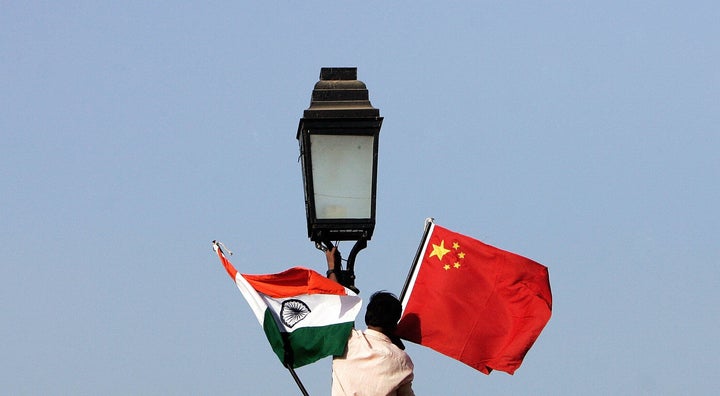
The clash last week between Indian and Chinese soldiers in the Galwan Valley in eastern Ladakh has prompted a discussion on the best way for India to respond to an aggressive China.
The 15 June incident left 20 Indian soldiers dead and unconfirmed reports say there are casualties on the Chinese side as well.
The clash also earned China condemnation from countries including the US. Calling China a “rogue state”, US Secretary of State Mike Pompeo accused it of undoing the gains made through institutions such as NATO. “The PLA (People’s Liberation Army) has escalated border tensions with India, the world’s most populous democracy. It’s militarising the South China Sea and illegally claiming more territory there, threatening vital sea lanes,” Pompeo said.
Admiral Arun Prakash (Retd), former Chief of Naval Staff, told HuffPost India in an email interview that China’s actions in the South China Sea are also a cause of concern for India because a substantial proportion of its seaborne trade and energy traffic transits through these waters.
A Vietnamese fishing vessel was rammed and sunk by the Chinese vessel in April and Beijing has also declared two new administrative districts in the South China Sea, prompting a protest from Vietnam.
Following the face-off, several analysts highlighted the need for New Delhi to strengthen the Quad (see here and here) and its maritime capabilities to put pressure on Beijing (see here and here).
Strengthening the Quad —comprising India, US, Japan and Australia— will certainly send a message of deterrence to China, said Admiral Prakash, adding that India could take the lead and motivate Quad members to become more active and visible as a grouping.
1. US has been encouraging India to play a more prominent role in the Indo-Pacific region. Can India still manage to take on a proactive role while it’s dealing with China in Ladakh as well as another upset neighbour Nepal?
If any service is to play a role in the Indo-Pacific, it will be the Indian Navy (IN), which is not directly impacted by developments in either Ladakh or Nepal. However, it must be borne in mind that America’s underlying motivation in inviting India to play a ‘more prominent role’ in the Indo-Pacific is selfish. It needs to relieve some of the operational load being borne by an over-stretched US Indo-Pacific Command in facing up to an overbearing China. India’s concerns and interests lie mainly in the Indian Ocean Region (IOR), where its naval assets are mainly deployed, but it does have a peripheral interest in the larger Indo-Pacific. However, given India’s current confrontation with China, IN deployments in the Indo-Pacific, jointly with the US Navy would send the right signals to China at this juncture.
2. The US has called India “a pillar of our common vision for free and open Indo-Pacific”. Can the US be a reliable partner for India in the Indo-Pacific?
The phrase “common vision for a free and open Indo-Pacific” is somewhat vague and rhetorical. Many other Indo-Pacific nations could have the same vision. Each nation, however, must always act in its own national interest. Under the current Trump regime, US actions have been erratic and whimsical and it cannot be seen as a ‘reliable partner’.

3. China has ramped up activities in the South China Sea. While some observers have said that Beijing is taking advantage of the Covid-19 crisis, others have claimed these are part of a long-term strategy. How concerned should India be about China’s moves in the SCS?
While India may not have any direct stakes in the South China Sea, a substantial proportion of its seaborne trade and energy traffic transits through these waters. Therefore peace, tranquility and freedom of navigation are issues of concern to India. China has been pursuing its hegemonic objectives for many years, as part of a long-term strategy, but Covid-19 seems to have lent added impetus to its nefarious activities and India does have cause for concern.
4. Do you think strengthening the Quad can be a way to deter China?
It could certainly send a message of deterrence to China and it needs to be done. But China sees the Quad as a US-inspired attempt at ‘containment’ and has repeatedly expressed displeasure about this concept. Therefore, each Quad member (other than USA) is individually apprehensive about China’s adverse reaction at a formal constitution of the Quad. Perhaps India should take the lead and motivate Quad members to become more active and visible as a grouping.
5. Some Indian analysts suggest that India should look at alternative ways to counter China’s aggression in Ladakh. One of the ways suggested is to use its naval power and put pressure on China in the Indian Ocean. How can this be achieved and is it an effective strategy?
It is certainly a viable strategy, if you consider that: China’s economy (No. 2 in the world) is underpinned by its status as the world’s No.1 manufacturing and trading nation. China’s booming economy and industry are entirely dependent on imported energy (oil and gas) as well as imported raw materials like iron ore, coal, copper & plastic and grains etc. The crucial fact is that over 90% of China’s energy, raw material and exports travel by sea on merchant shipping. These merchant ships travel along ‘sea lanes’ which run from South China Sea, via Malacca Strait, across the Indian Ocean to Africa, Middle East and Europe. Thus, for thousands of miles, these sea lanes and China’s shipping traffic are vulnerable to interference, interdiction or capture. Any interruption to China’s shipping will upset its economy. This thought has worried China’s leaders for decades, leading Hu Jintao (Xi Jinping’s predecessor) to speak of the ‘Malacca Dilemma’. The Indian Navy is in ‘home waters’ in the Indian Ocean and well-positioned to threaten China’s shipping and hence its economy.
6. How can India materialise Modi government’s SAGAR vision? Have any steps been taken in this direction?
So far, ‘SAGAR’ remains a slogan and lacks a viable strategy for its elaboration and implementation.
7. Where do you think India’s strategy faltered in dealing with China along the LAC?
The fact that we have not been able to find a solution to this 70-year old boundary dispute indicates a lack of resolve and determination on part of India’s politicians as well as diplomats. There are no other neighbouring nations anywhere else who have left their boundaries un-determined, unmarked and unresolved, and failed to even exchange maps. Such a situation is like a ticking time-bomb ready to explode any time, and should have been resolved decades ago through continuous negotiations.